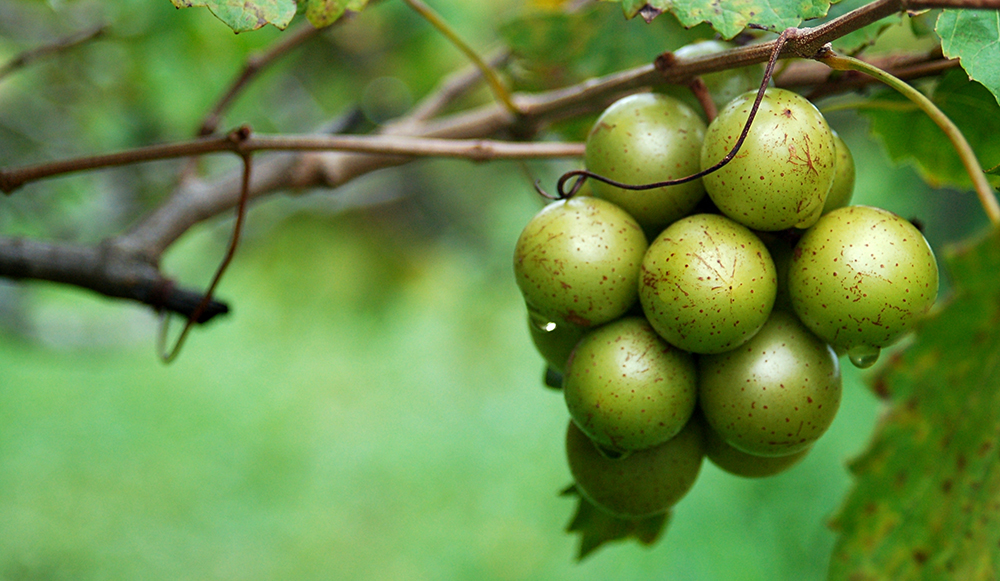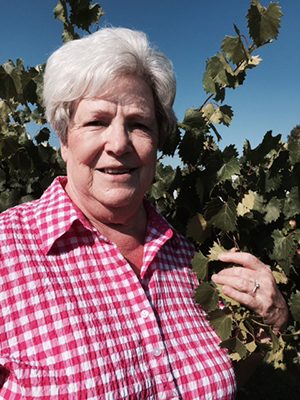Alabama’s only native grapes are as full of valuable nutrients as they are flavor.
Muscadine grapes (of which scuppernongs are one variety) are the native grape of the Southeast and have been growing wild all over the region for centuries. Their verdant vines produce round, plump fruit that once nourished Native Americans, and they were discovered growing freely, climbing up trees and tangling over brush, by Europeans colonizing North Carolina. Today, this grape variety is cultivated all over Alabama in backyards, on farms and at wineries, and wild vines still twist around trunks tucked away in forests and tumble and crawl over fence posts on the edges of fields.
When I was a kid, my mama’s daddy had four lines of scuppernong vines off to one side of his backyard. On any late summer or early autumn visit, my attention was fixed on the sun-warmed, speckled golden orbs that hung from the vines, almost hidden beneath wide green leaves. I’d pick as many as I could reach and pop them in my mouth, devouring their distinct sweetness, earthy and woodsy. The grapes’ thick, sinewy skins make you work for even the tiniest taste; you have to chew through that rubbery exterior while your teeth dodge slippery, bitter seeds. But boy, is it worth it.
I still like eating muscadines straight out of hand. No muss. No fuss. Just a cup for spitting seeds in. They also hold up well to cooking and lend their sweetness to this month’s reader submitted recipes.
– Jennifer Kornegay
Cook of the Month
Sue Wiley and her husband Tom love muscadines. They’ve grown two rows of muscadine vines they started as a hobby into a 220-vine, you-pick operation. Tom enjoys the growing process. “And my pleasure comes from eating them, especially the black varieties, and visiting with our many repeat customers,” Sue said. She started making basic muscadine jellies, but Tom encouraged her to make some that included the hull, so she did, and this version quickly became his favorite. “He really likes the texture,” she said. “It just adds something extra.”
Muscadine Hull Jelly
- 5 pounds muscadines (black or bronze)
- 6 cups sugar
- Water
- 1 box Sure Jell
Prepare jars and flats before starting jelly. Keep both in hot water. Wash muscadines. Cut muscadines in half and remove hulls. Cut up hulls. Place hulls in a pan and just cover with water. Cook on medium heat until tender, about 10 minutes. If water gets low, add more. When tender, remove from heat and set aside. Place pulp in pan and cover with water. Cook about 15 minutes on medium heat, stirring occasionally. Remove from heat and press through sieve to remove seeds. Mix hull mixture and seedless pulp mixture together. You will need 6 cups of this.
Place in large pan and add Sure Jell. Mix well and bring to a rolling boil, stirring constantly. Add sugar, mix well and return to a rolling boil. Boil for 1 minute, stirring constantly. Remove from heat. Skim off foam. Pour into hot jars to ¼ inch from the top. Wipe jar top and cover tightly with lid. Place in water bath for 10 minutes. Remove jars and place on towel-covered counter to cool. When cool, press on top of lid to check if it’s sealed. If it’s sealed, it won’t spring back. Refrigerate any unsealed jars. Yield 5-6 pints, or 10-12 half-pints.
Muscadine Juice
- 4 cups freshly washed muscadines
- 2 cups sugar
Place in bottom of a sterilized hot gallon jug. Pour into it a gallon of rapidly boiling water. Seal with hot sterilized lids. Let set 4-6 weeks before using.
Cook’s note: Sugar can be reduced to 1 cup.
Barbara Woodard, Joe Wheeler EMC
Muscadine Cobbler
(from the alabamaliving.coop archives)
Filling:
- 2 1/2 pounds muscadines
- ¹⁄4 cup plain flour
- 11/2 cup sugar
- 2 tablespoons fresh lemon juice
Cobbler:
- Basic pastry dough for 2-crust pie, unbaked
- 1 quart prepared muscadine pie filling
- 2 tablespoons unsalted butter
To prepare filling, wash muscadines and squeeze pulp from hulls, reserving hulls for later use. Heat pulp with juice over low heat until seeds begin to separate (about 45 minutes). Press pulp through a colander to remove seeds; save the pulp and juice and discard seeds. Combine pulp and juice with reserved muscadine hulls and cook over low heat, covered, until hulls are tender, 30-40 minutes. Add flour and 11/2 cups sugar (more or less, depending on sweetness of muscadine). Cook until pie filling consistency is reached. Add fresh lemon juice. Preheat oven to 400. Roll out 1/2 pastry dough to 1/8-inch thickness and cut into strips. Arrange in lattice pattern on top. Sprinkle with sugar and bake 10 minutes at 400. Reduce heat to 350 and bake 25-30 minutes longer. Serve hot. Delicious right out of the dish and also with homemade vanilla ice cream.
Note: Muscadine pie filling freezes well. When using frozen filling, add lemon juice for freshness or sugar for sweetness.
Ashley Parkman Smith, Tallapoosa River EC
Muscadine Syrup
(from the alabamaliving.coop archives)
- 21/2 pounds muscadines (about)
- 13/4 cups sugar
- 1/3 cup corn syrup
- 1 tablespoon lemon juice
Wash and crush muscadines. Cook over low heat 10 to 20 minutes. Put muscadines through a sieve. Discard hulls and seed. Measure 11/2 cups muscadine puree in a sauce pan. Add sugar, corn syrup and lemon juice. Bring to a full boil for about two minutes. Remove from heat. Skim off foam with a spoon and pour quickly into sterilized jars. Leave 1/4-inch head space. Cover with lids and process in a boiling water bath for 10 minutes. Yields about 11/2 pints.
Annette Lackey, Coosa Valley EC
Muscadine Compote
- 21/2 cups muscadines
- 2 tablespoons balsamic vinegar
- 2 tablespoons chopped shallots
- 1 teaspoon brown sugar
- Pinch salt
- 1/4 teaspoon chopped fresh rosemary
Take 1/2 cup of the grapes and cut them in half. Remove the seeds with the point of your knife. Set aside. Put the remaining 2 cups of the grapes in a saucepan with 1/4 cup of water and cook over medium-high heat until the grapes break down. Use a potato masher or wooden spoon to mash all the grapes in the pot. Pour the contents of the pot through a fine strainer over a bowl, pushing on the grapes to get all the juice. Discard the seeds and skins. Put the juice back in the saucepan with the halved grapes, the balsamic, the shallots, the rosemary, the salt and the sugar and bring to a boil. Cook until the compote is reduced and thickened, about 5 minutes.
Jennifer Kornegay, recipe editor
Send us your recipes!
Recipe Themes and Deadlines:
Nov. Biscuits Sept. 8
Dec. Christmas Cookies Oct. 8
Jan. Comfort Food Nov. 8
Good & Good For You
- There are multiple varieties of muscadines (including the popular scuppernong).
- They come in both red and gold.
- They are thicker-skinned and more bulbous than other grapes.
- Muscadines have 20 pairs of chromosomes while all other grape varieties have 19. This extra pair is why muscadines boast a higher antioxidant content than any other grape.
- They also have far more resveratrol, a component believed to possess some potent cancer-fighting properties.
- Muscadines are a great source of the trace mineral manganese and have more dietary fiber than oat bran.




